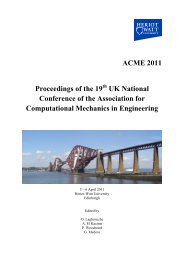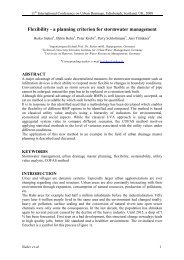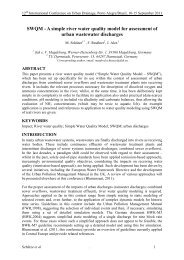PhD Thesis - Automated Recognition of 3D CAD Model Objects in ...
PhD Thesis - Automated Recognition of 3D CAD Model Objects in ...
PhD Thesis - Automated Recognition of 3D CAD Model Objects in ...
Create successful ePaper yourself
Turn your PDF publications into a flip-book with our unique Google optimized e-Paper software.
Literature Review 10<br />
author attempts here to estimate, mostly qualitatively, such performance expectations.<br />
These are used <strong>in</strong> the rest <strong>of</strong> this thesis for assess<strong>in</strong>g the performance <strong>of</strong><br />
automated <strong>3D</strong> object recognition systems with<strong>in</strong> the <strong>in</strong>vestigated context.<br />
Accuracy: Accuracy refers to the performance <strong>of</strong> the system to correctly extract<br />
from a given scan all the as-built po<strong>in</strong>t clouds correspond<strong>in</strong>g to project <strong>3D</strong><br />
objects, and to correctly assign each extracted range po<strong>in</strong>t to the right object.<br />
Such performance can be measured us<strong>in</strong>g fundamental recall rate, specificity<br />
rate, etc. While perfect recall rates could be expected, the recognition <strong>of</strong> the<br />
as-built po<strong>in</strong>t cloud <strong>of</strong> certa<strong>in</strong> project <strong>3D</strong> objects could also be considered<br />
more critical than <strong>of</strong> other ones. For <strong>in</strong>stance, when consider<strong>in</strong>g a scan <strong>of</strong><br />
a steel structure, it can be argued that it is more critical, both for dimensional<br />
quality control and progress track<strong>in</strong>g, to be able to correctly extract<br />
the as-built po<strong>in</strong>t clouds <strong>of</strong> all beams and columns than <strong>of</strong> panel braces. In<br />
the <strong>in</strong>vestigated context, it is thus difficult to quantitatively set targets for<br />
performance measures such as recall rate, and a qualitative analysis <strong>of</strong> object<br />
recognition results may be preferred. Nonetheless, these fundamental measures<br />
are used <strong>in</strong> this thesis with the goal <strong>of</strong> sett<strong>in</strong>g benchmarks that can be<br />
used for comparison with future research results.<br />
Robustness: Robustness refers to the performance <strong>of</strong> the system to correctly extract<br />
<strong>3D</strong> objects’ po<strong>in</strong>t clouds <strong>in</strong> laser scans with different levels <strong>of</strong> clutter<br />
and, more critically, occlusions. This is very important s<strong>in</strong>ce, as is shown <strong>in</strong><br />
Figure 2.3, objects are <strong>of</strong>ten scanned with partial and sometimes significant<br />
occlusion. In the <strong>in</strong>vestigated context, an object recognition system should<br />
be able to recognize objects with high levels <strong>of</strong> occlusions.<br />
Note that occlusions can be categorized <strong>in</strong> two types: (1) <strong>in</strong>ternal occlusions<br />
are due due to other project <strong>3D</strong> objects (e.g. columns and walls); and<br />
(2) external occlusions are due to non-project objects (e.g. equipment and<br />
temporarily stored materials). A good system should be robust with both<br />
types <strong>of</strong> occlusions.<br />
Efficiency: Efficiency refers to the speed <strong>of</strong> the <strong>3D</strong> object recognition system. Such<br />
a system is <strong>in</strong>tended to support many applications such as progress track<strong>in</strong>g<br />
and dimensional QA/QC that provide key <strong>in</strong>formation to design-mak<strong>in</strong>g<br />
processes. Thus, hav<strong>in</strong>g real-time project <strong>3D</strong> status <strong>in</strong>formation would be<br />
preferable. However, as discussed previously, currently available systems for<br />
progress control provide <strong>in</strong>formation on a daily basis at best, and, as is reported<br />
by Navon and Sacks [87], construction managers do not (yet) seem<br />
to have a strong desire for <strong>in</strong>formation updates at a higher frequency than<br />
daily. S<strong>in</strong>ce the time needed to conduct a site laser scan is <strong>in</strong> the order <strong>of</strong>













